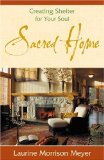
Sacred Home: Creating Shelter for Your Soul
, by Laurine Morrison Meyer
Llewellyn Worldwide, 0738705853, 247 pp. (incl. bibliography, suggested reading and index), 2004
The introduction describes this as a book on decorating, as do the promo sheets that accompanied it, and the rear cover, but much of the text is taken up with pseudo-history of Goddess lore, with loose associations to family-related material, such as fire, the hearth and home, child-bearing, etc.
It becomes clear early on that the major focus of the book seems to be on household deities, spirits, lars, and ancestors there is a major focus on female or neutral deities with only a short paragraph toward the end of the book on male deities.1 Meyer even gives an rather detailed account of the matriarchal societies that allegedly existed before patriarchy took over, which she describes as fact rather than theory. However the link between this and household spirituality is tenuous at best, and the relevance to the topic at hand is unclear, and at times stretched beyond obvious reasoning. For example, Meyer writes, ‘Although their [the Domovoi] appearance was similar to humans, they were covered with a sort of silky fur and sometimes depicted with horns and a tail (probably a leftover from the demonized female house spirit)…’ (pg 55) Though she’s left no indication of how she drew this conclusion based on a description of a Russian house spirit. Why female deities and spirits are given prominence in this mythology is barely touched on.
Meyer explains: ‘When we furnish houses strictly for the function of the bodies that will inhabit them, or to create a certain style, we lose touch with this vital animating principle. To create a home that feels spiritually alive, we must be mindful of our deepest thoughts and feelings, our connection to wise elders and ancestors, and to what lies at the very center (sic) of our beings’.2
However, she also states that ‘it is not possible to eliminate aggression by deeming it hateful and imprisoning it. We must seek to acknowledge and incorporate our own aggression – not disown it, or euphemize only the cooperative and placid.‘ Further she explains that ‘we must find the common basis for respect of all human beings, all animals, and all matter. We must reincorporate the sacred in every aspect of our lives and our thinking. Bringing spirituality back into our homes is a step in the right direction for regaining personal power and thus balancing the sale between rigid dogma and intuitive personal belief.’3
Meyer’s description of the difference between what should be considered superstition and what is sacred represents a rather one-sided attitude ‘if the dogma you are considering is shrouded in fear, then you are looking at superstition,. If, on the other hand, you adopt symbols and rituals that instill acceptance and reference toward all life and all beings, you are embracing sacred principles’.4 There is a bit of a mixed message in that Meyer seems to be advocating one, while demonizing the other, yet she has a section describing protections against the evil eye.
In Part Two the focus finally turns to design. Design concepts are described through the classical four elements and spirit and Tarot cards depicting archetypical styles. A breakdown is given including design elements, colours, patterns, textures and fabrics, building materials, architecture and furnishings with descriptions of balancing and clashing styles. This format is interesting, though it would have benefited from more pictures. Aside from a few symbols at the beginning, the only pictures are of Tarot cards.
Also presented in the second half are a few rituals and house warming ideas.
Overall, an interesting idea, but unless one is already familiar with design, more visual references would be useful in making this more practically applicable.








